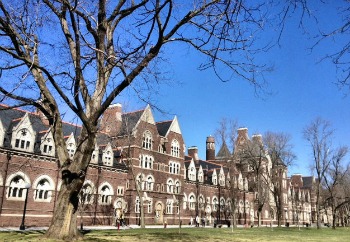
Yale University’s New Haven campus is famous for its gloomy Gothic Revival buildings, but Trinity College, right here in Hartford, can rival the southern Connecticut school with its own brand of Gothic, which its website calls a “harmonious and imaginative blending of 19th-, 20th-, and 21st-century architecture.”
I didn’t have any great expectations for my visit to the Trinity campus, mostly because I have no particular affinity for the classic college setting. I went to a university in a large city that had no definitive boundaries. There was no gate, no wall, nothing except your schedule and stage in life to separate you, the student, from the rest of the city’s residents. When I visited friends at schools with quads and parking lots and such, I always returned home relieved that I wasn’t confined into a similar pretty box. At that age (and even now) I wouldn’t have lasted in that environment for a week.
But Trinity surprised me. The school is located at the top of a rise - the name Summit Street wasn’t chosen simply because it sounded good - and the views of the city below make the campus feel physically set apart but not cut off from the rest of Hartford.
Trinity provides a nice self-guided walking tour of the campus on their website, and I started by following that, walking through the Hogwarts-esque archway of the Downes Memorial Clock Tower, past the impressive Chapel, and onto the Quad.
The main attraction of Trinity’s campus is the Long Walk, a row of classrooms, offices, and residence halls on one side of the Quad’s green lawn. Though recently renovated, these buildings are the school’s oldest, completed in 1787. They are the kind of old buildings that usually strike Americans as particularly European: their roofs are dotted with artfully mismatched little peaks, and small stone faces look out from each side of their wooden doors. As I walked along the path beside them, I looked up and saw that many of their tiny windows were flung open.
Turning the corner, I walked along the Quad, where – my walking tour informed me - the trees are planted in the shape of a T. At the center of the open expanse of grass was a statue of Bishop Thomas C. Brownell, one of the college’s Episcopal founders. Despite its origins, Trinity is now nonsectarian; the Chapel hosts interfaith events.
I did not follow the entirety of the walking tour, which is supposed to take 45 minutes, but walked in a rectangular loop past the athletic fields and some unobtrusive modern buildings.
I (or rather my inner 17-year-old) felt very slightly claustrophobic wandering this manicured setting. But at the same time I was taken with how attractive the grounds were, and how, although Trinity looked like the opposite of my own alma mater’s environment, they both made for a perfect urban walk.
Trinity had previously been on my radar because it is home to Cinestudio, an old-school, independent movie theatre that’s been on my list of Hartford things to do since I moved here. Recently the school has also been in the news because of its newly-named President. Joanne Berger-Sweeney represents twin firsts for the college, being the only woman and the only African American to hold the position in its history. With all that, plus its quintessential college atmosphere, this is a school worth taking a few minutes to see, whether you live in Hartford or are just passing through.
For directions and more information, visit www.trincoll.edu.
H